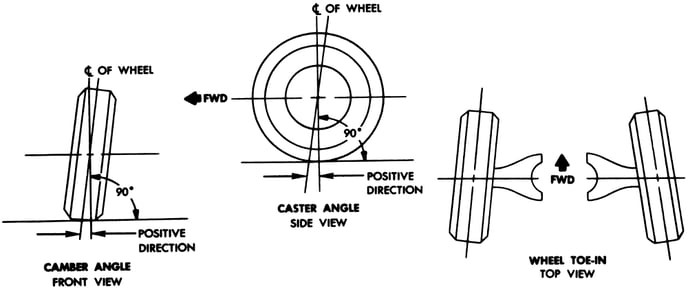Mastering the Art of Camber Caster Angle: The Essential Guide to Vehicle Alignment
Hey, off-road enthusiasts! We know how vital vehicle alignment is to your adventures. So today, we're diving deep into the nitty-gritty of camber and caster angles. Understanding these concepts can transform your driving experience, especially when you're dealing with lifted vehicles or using our JBA upper control arms. So, buckle up and get ready for an exciting journey, exploring the ins and outs of camber caster angle!
What are Camber and Caster Angles?
First things first, let's define what camber and caster angles are.
Camber angle is the tilt of your tire when viewed from the front. If the top of the tire leans out from the vehicle, it's a positive camber. If it leans inwards, that's negative camber. Camber impacts the way your vehicle handles cornering and tire wear.
On the other side, we have the caster angle. When looking at your vehicle from the side, the caster angle is the tilt of the steering knuckle or axis (the line drawn through the upper and lower ball joints) relative to vertical. A positive caster means the steering axis tilts towards the driver, while a negative caster tilts towards the front of the vehicle. Caster affects steering stability and alignment.

The Significance of Camber and Caster Angles
So why should you care about camber and caster angles? Well, they play a significant role in how your vehicle performs and handles on the road.
The camber angle affects tire grip. When you take a corner, the centrifugal force pushes your vehicle outwards. A negative camber helps keep the tire flat on the road, improving grip and cornering ability. However, too much negative camber can lead to excessive tire wear on the inside edge.
The caster angle, on the other hand, affects your vehicle's steering. A positive caster improves straight-line stability, making the vehicle easier to control. But too much positive caster can make steering harder and increase tire wear.
The Unique Case of Lifted Vehicles
Now, let's talk about lifted vehicles. When you lift a vehicle, it can change the camber and caster angles. This is where our JBA upper control arms come in handy! They offer more caster for lifted vehicles, which helps maintain proper alignment and performance.
Lifted vehicles typically need a positive caster between 3 and 4 degrees during a front-end alignment. This setting helps counteract the changes in geometry caused by the lift, ensuring that your vehicle remains stable and easy to steer.
Decoding JBA Upper Control Arms
We offer two types of upper control arms: STD and HD high caster arms. Both are designed to improve your vehicle's suspension geometry, but they serve different purposes.
Our STD arms are perfect for those who want to replace their stock upper control arms on a lifted daily driver. They provide an extra degree of caster, improving handling and reducing tire wear.
Meanwhile, our HD high arms are meticulously engineered for the toughest offroad vehicles. Perfect for offroad racing, extreme rock crawling, and conquering sand dunes. These high arms offer enhanced alignment and optimal performance, thanks to the increased caster. Experience the ultimate offroad capability and keep your lifted vehicle in perfect harmony.
Adjusting Camber and Caster Angles
There are various methods to adjust camber and caster angles. Some involve using specialized equipment like alignment racks, while others require aftermarket parts like adjustable control arms.
For minor adjustments, shims or eccentric bolts can be used. These are inexpensive and relatively easy to install. However, they may not offer enough adjustment for heavily modified or lifted vehicles.
For more substantial adjustments, aftermarket parts like our JBA upper control arms are the way to go. They provide built-in camber and caster and are built to withstand the rigors of off-road driving.
In conclusion, understanding camber and caster angles is crucial to optimizing your vehicle alignment, especially if you're into off-roading or have a lifted vehicle. Remember, proper alignment can improve your on-road driving experience and extend the life of your tires. JBA upper control arms make aligning your lifted vehicle simple!
